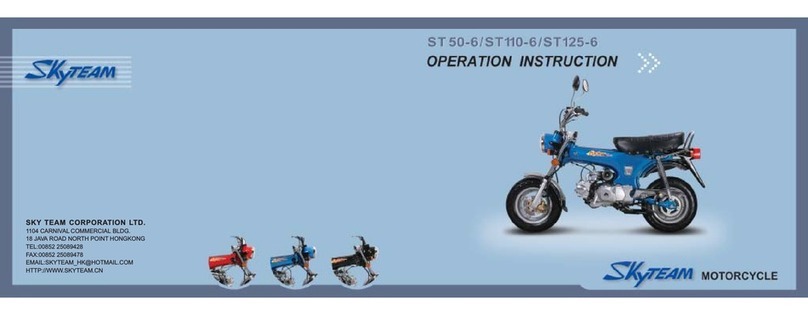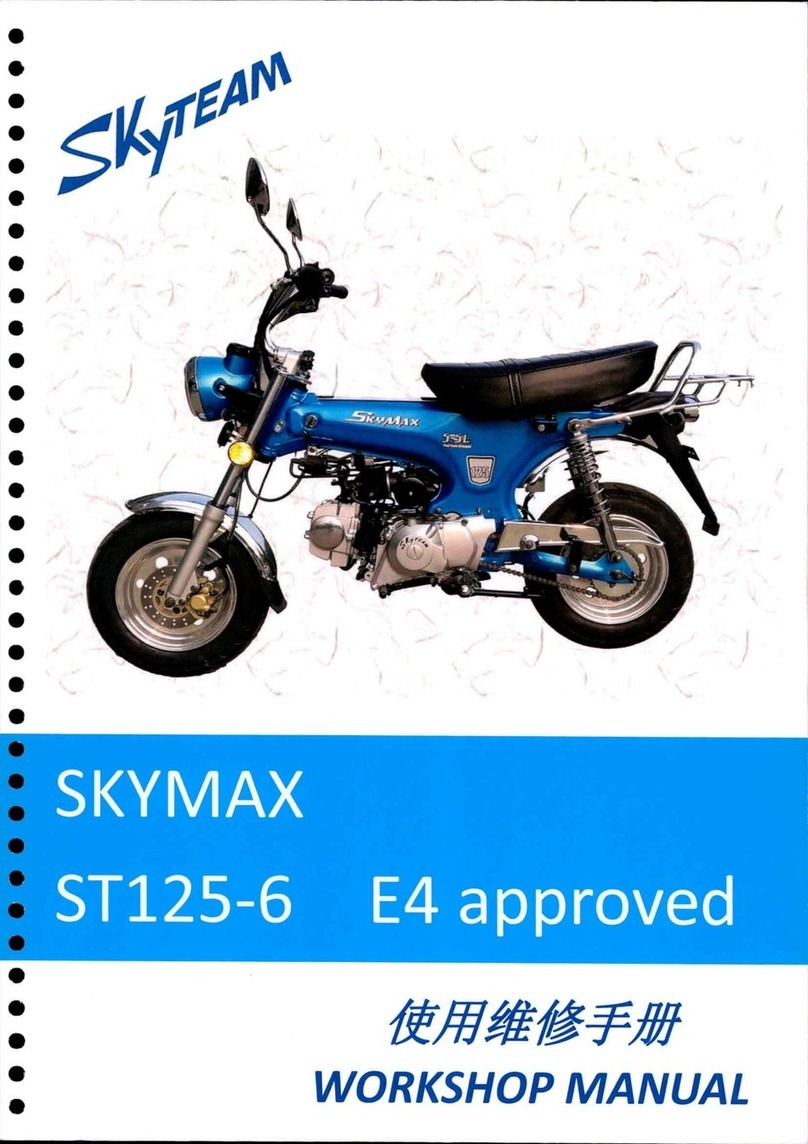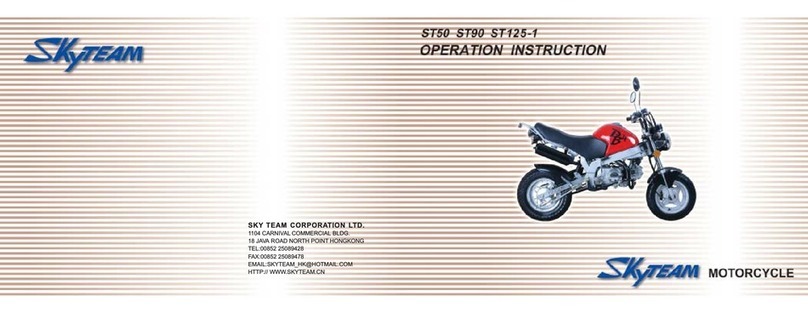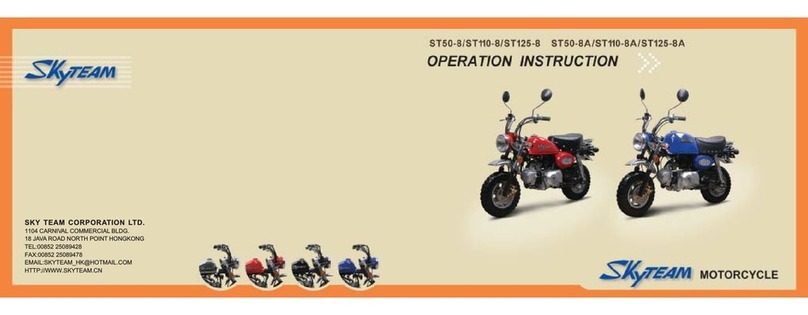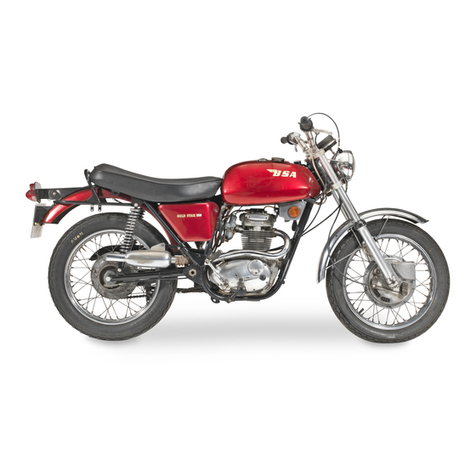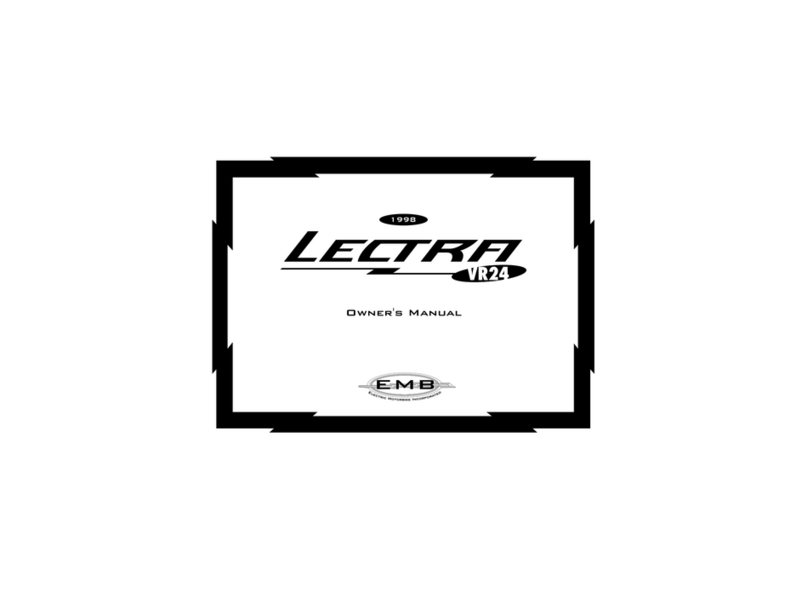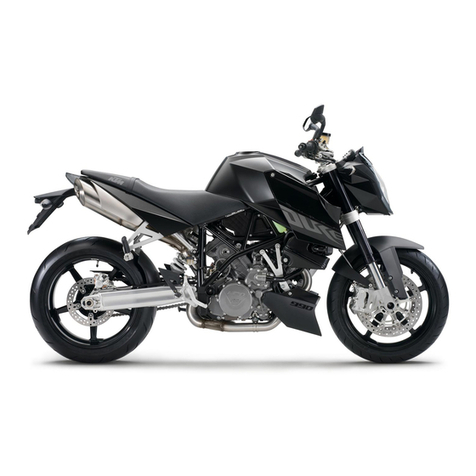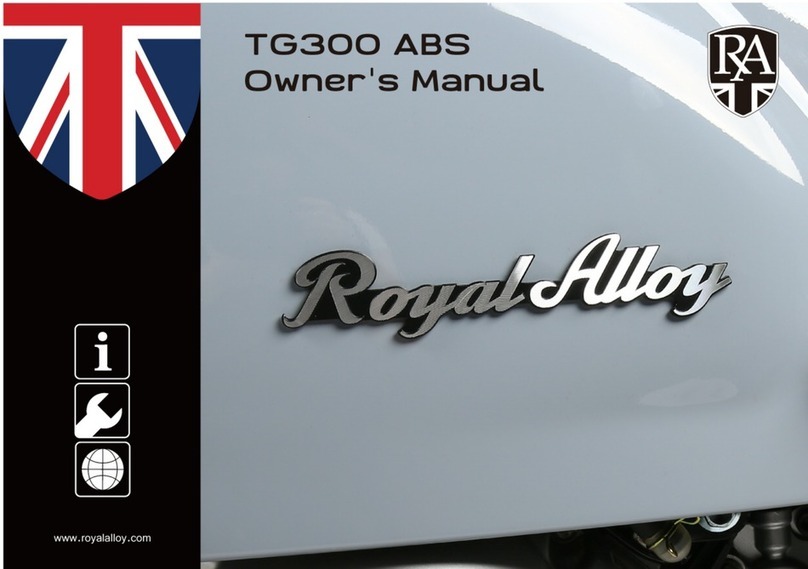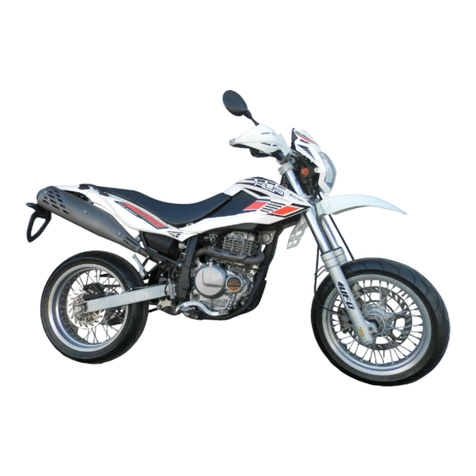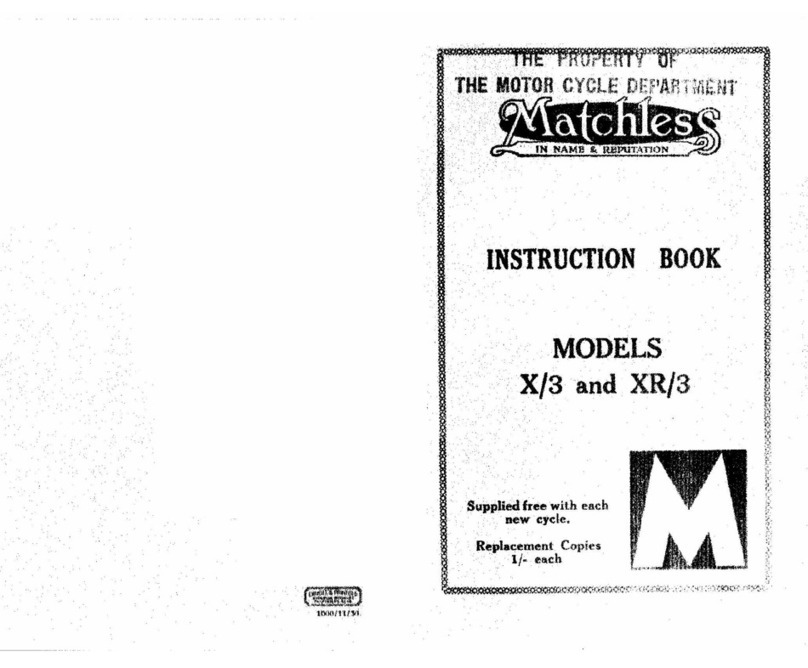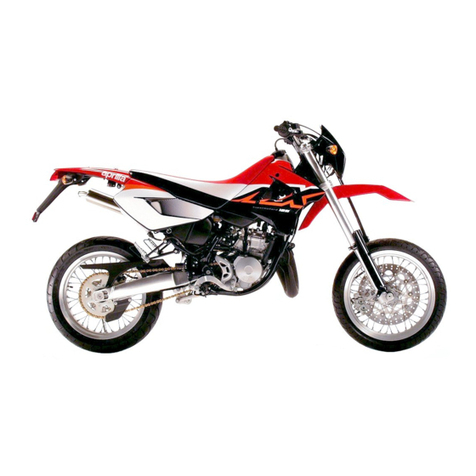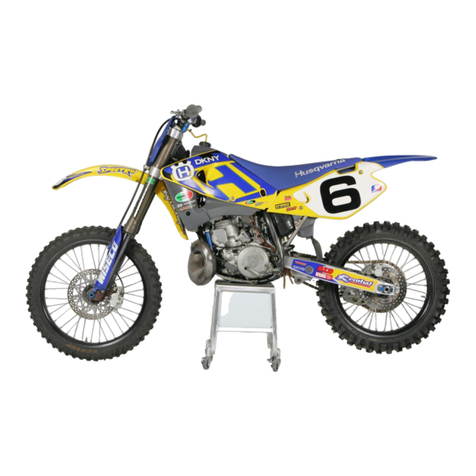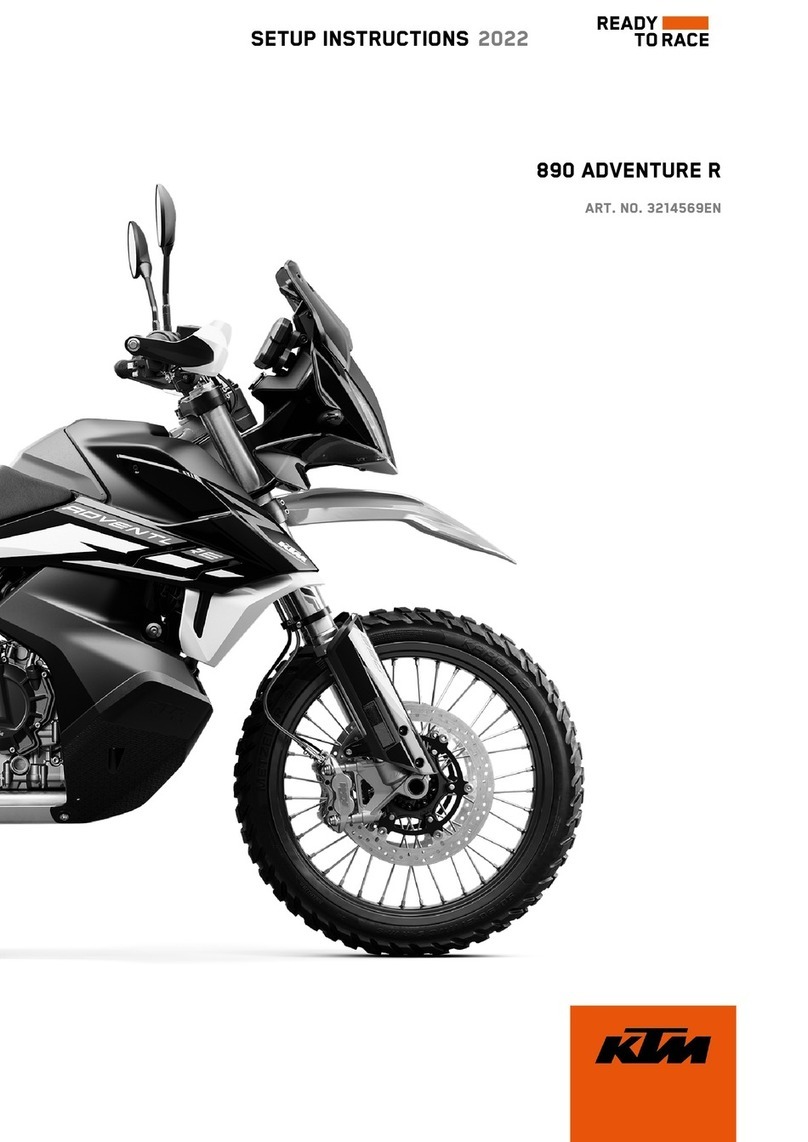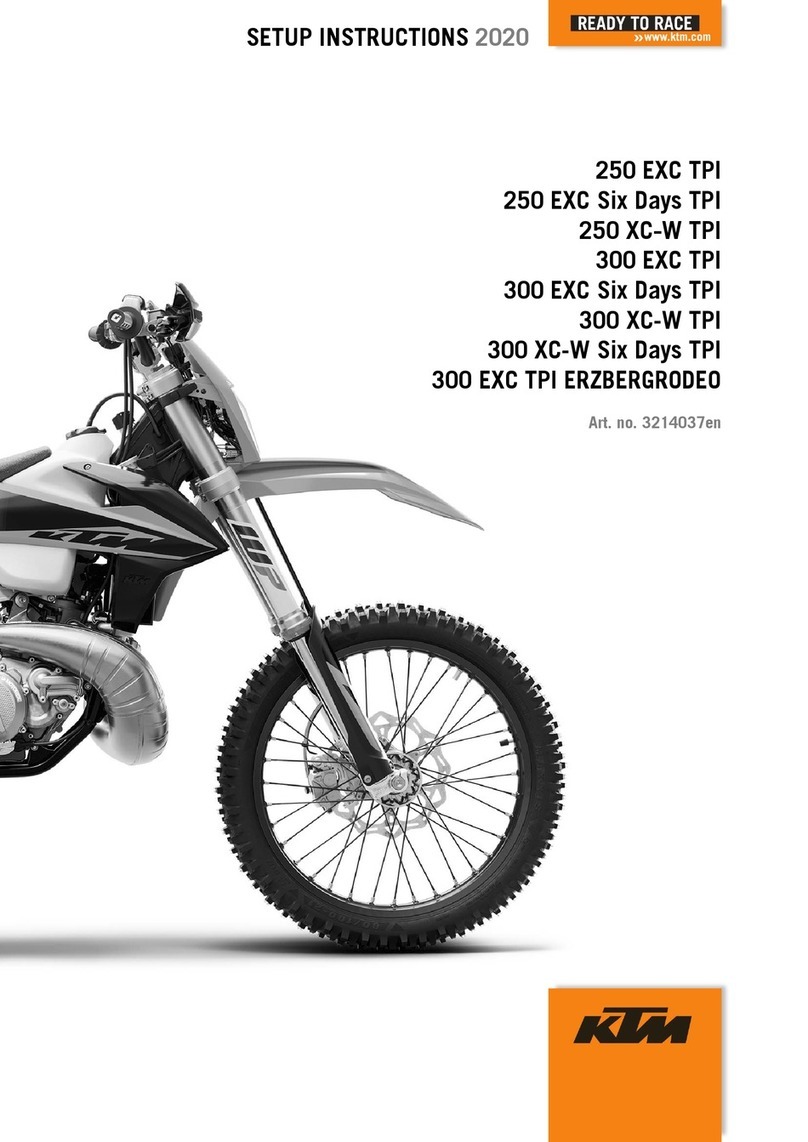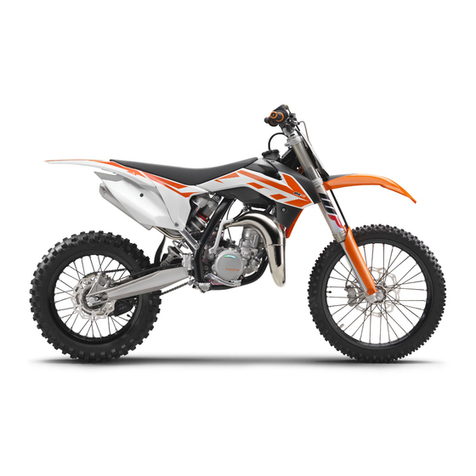Skyteam ST50-3SM Technical manual

SKY TEAM CORPORATION LTD.
1104 CARNIVAL COMMERCIAL BLDG.
18 JAVA ROAD NORTH POINT HONGKONG
TEL:00852 25089428
FAX:00852 25089478
EMAIL:[email protected]
HTTP://WWW.SKYTEAM.NET.CN
//WWW.SKYTEAM.CN

TABLE OF CONTENTS
OPERATION
Page
1
2
6
9
9
12
14
17
18
23
23
24
25
26
27
Important Precautions
Consumer Information
Parts Location
MAJOR COMPONENTS
(Information you need to operate this motorcycle)
Brakes
Clutch
Fuel
Engine Oil
Tires
ESSENTIAL INDIVIDUAL COMPONENTS
Ignition Switch
Instrument panel
Left handlebar
Right handlebar
OPERATION
Page
27
29
32
33
35
36
37
37
Pre-ride Inspection
Starting the Engine
Running - in
Riding
High Altitude Riding
Braking
Parking
Anti-theft Tips
MAINTENANCE
Page
38
38
39
40
41
44
45
46
49
51
52
54
59
60
60
61
MAINTENANCE
The Importance of maintenance
Maintenance Safety
Safety Precautions
Maintenance Schedule
Serial Number
Air Cleaner
Engine Oil
Spark Plug
Idle Speed
Throttle Operation
Drive Chain
Wheel Rims and Spokes
WHEELREMOVAL
Front Wheel Removal
Rear Wheel Removal
Page
63
64
65
66
69
69
70
71
Front Suspension
Rear Suspension
Side Stand
CLEANING
STORAGE GUIDE
Storage
Removal from Storage
SPECIFICATIONS

BREAK-IN INFORMATION FOR YOUR
MOTORCYCLE
The first 1,600km is the most important in the
life of your motorcycle. Proper running-in
operation during this time will help ensure
maximum life and performance of your new
motorcycle
Motorcycle reliability and performance depend
on special care and restraint exercised during
running-in period. It is important that you avoid
operating the engine in the manner which could
expose the engine parts to excessive heat.
Please refer to the “running-in”section for
specific running-in recommendation.
Please read this manual and following its
instructions carefully.
To emphasize special information, the words
WARNING and NOTICE carry special meaning
and should be carefully reviewed.
IMPORTANT PRECAUTIONS
WARNING:
The personal safety of the rider may be involved,
disregarding this information could result in
injury to the rider.
NOTICE:
These instructions point out special service
procedures or precautions that must be followed
to avoid damaging the machine and make
maintenance easier or important instructions
clearer.
1
CONSUMER INFORMATION
ACCESSORY INSTALLATION AND
SAFETY PRECAUTION TIPS
There are great varieties of accessories available
to SKYTEAM owners. The addition of
unsuitable accessories can lead to unsafe
operating conditions. For proper installation of
accessories, we have laid down some principles
which will help you for the correct choice and
installation of accessories.
(1) If you want to install an accessory which will
result in an extra weight or an aerodynamic effect
to your motorcycle, try to install it as low as
possible and as close as possible to the center of
gravity of your motorcycle. Check carefully the
holder for installing accessories to make sure for
its firmness. The infirm installation will lead to
unstable and dangerous conditions due to weight
deviation.
(2) Check the net clearance and turning angle to
make sure that they are adequate. The improper
load, which may occur after installing
accessories,will very likely lower their safety
factors.Checks should also be made that this
improper load will not hinder the idling,tunning
and other control actions.
(3)Fixing the accessories on handlebars or front
fork will result in unstable operation.This extra
weight will reduce the maneuverability of your
motorcycle during turning operations, meanw-
hile,this extra weight will also cause unstable
condition due to vibration at the front
end.Therefore,fixing accessories on handlebars
or front fork should be minimized.
(4)Things like windglass,windshield, waist
support, bags across seat and suitcases all have
an aerodynamic effect on the stability of your
motorcycle, when there is a side wind or large
vehicles passing by. The improper installation
or bad design of accessories will affect your
driving safety.Therefore,you should be careful
for the choice and installation of accessories.
(5)Certain accessories displace the rider from his
normal riding position.This will not only limits
the freedom of movement of the rider,but also
his control ability.
(6)Extra electrical accessories may overload the
2

existing electrical system.Severe overloads may
damage the wiring harness or create a dangerous
situation due to the loss of electrical power during
the operation of the motorcycle.
When carrying a load on the motorcycle,
mount it as low as possible to the motorcycle.An
improperly mounted load can create a high center
of gravity which is very dangerous and make
the motorcycle difficult to handle.The size of a
load can affect the aero-dynamics and the
handling of the motorcycle.Balance the load
between the left and right side of the motorcycle
and fasten it firmly.
SAFE RIDING RECOMMENDATONS
FOR MOTORCYCLE RIDERS
Motorcycle riding is a great joy and an
exciting sport.Motorcycle riding is also requires
that some extra precautions be taken to ensure
the safety of the rider.These precautions are:
WEAR A HELMET
Motorcycle safety equipment starts with a
quality safety helmet.One of the most serious
injuries that can happen is ahead injury.Always
wear a properly approved helmet.You should
also wear suitable eye protection.
RIDINGAPPAREL
Tight,fancy clothing can be uncomfortable and
unsafe when riding your motorcycle.Choose
good quality motorcycle riding apparel when
riding your motorcycle.
3
CHECKS BEFORE RIDING
Review thoroughly the instructions in the "PRE-
RIDE INSPECTION" section of this manual.Do
not forget to perform all the safety checks to
ensure the safety of the rider
FAMILIARIZE YOURSELF WITH
THE MOTORCYCLE
Your riding skill and your mechanical
knowledge form the safe riding practices.We
suggest that you practice riding your motorcycle
in an non-traffic situation without obstacles until
you are thoroughly familiar with your machine
and its controls.Remember that practice makes
perfect.
KNOW YOUR SAFETY SPEED
LIMITS
Ride within the boundaries of your own skill
at all times.Knowing these limits and staying
within them will help you to avoid accidents.
BE EXTRA SAFETY CONSCIOUS ON
BAD WEATHER DAYS
Riding on bad weather days, especially wet ones,
requires extra caution.Braking distance doubles
on a rainy day.Stay off the painted surface
marks,manhole covers and greasy appearing
areas as they can be especially slippery.Use
extreme caution at railway crossings and on
metal grating and bridges. Whenever in doubt
about road condition.SLOW DOWN!
AUTOMOBILE/MOTORCYCLE
ACCIDENTS PREVENTION
Many automobile/motorcycle accidents
happen because the automobile driver does not
"SEE" the motorcyclist
Make yourself conspicuous to help avoid the
accident that wasn't your fault:
.Wear bright or reflective clothing
.Don't ride in another motorist's "blind spot".
.Signal before you make a turn or lane change.
Your size and maneuverability can surprise other
motorists.
4

MODIFICATION
Modification of the motorcycle, or removal
of original equipment may render the vehicle
unsafe or illegal .Obey the local regulations for
available equipment.
5
PARTS LOCATION
Clutch lever
Fuel fill cap
Engine stop button
Front brake lever
Throttle grip
6

Rear brake pedal
Footpad
Kick starter
7
Ignition switch
Fuel valve
Choke lever
Gearshift pedal Footpad Side stand
8

BRAKE LINING
The main points for checking the front brake
lining are to see whether the lining wear is out
of the range. Replace the brake lining wear is
out of the range. Replace the brake lining if the
lining wear is beyond the brake wear limit mark.
FRONT BRAKE FLUID LEVEL
==Check that the fluid level is above the lower
level mark(1) with the motorcycle in an upright
position.
=Brake fluid must be added to the reservoir
when ever the fluid level begins to reach the
lower level mark(1). Fill the reservoir up to upper
level mark.
REAR BRAKE FLUID LEVEL
There are two marks in rear brake fluid
cap,keep the fluid lever between the Max. fluid
level mark(2) and the Min. fluid level mark
(3) always.
Check if it is short of brake fluid, check the
hose and other components for corrosion or
cracks.
limit mark
Brake Pad
Front brake Rear brake
If the brake system or brake linings have to
be repaired, we suggest that these repair should
be performed by your authorized SKYTEAM
dealer. SKYTEAM dealer knows your
motorcycle best and is dedicated to your
complete satisfaction.
WARINING
>
NOTICE
10
MAJOR COMPONENTS
(Information you need to operate this
motorcycle)
BRAKES
This motorcycle has a hydraulic brake system
of front and rear . Brakes are items of personal
safety and should be properly adjusted.
Remember to check periodically the brake
system and these checks should be conducted
by qualified Jincheng dealer.
Do not use the remained brake fluid from on a
unsealed container, never reuse the brake fluid
remained in the last repairing, because the used
brake fluid may absorb the water from the air.
Use DOT 4 brake fluid from a sealed container.
Do not spill out the brake fluid, when the brake
fluid is glued to the paint, plastic and rubber
material, a chemical reaction shall take place,
causing the damage.
(1)lower level mark
Front brake Rear brake
BRAKE FLUID (1)
(2)
(3)
(1)
(1)Brake fluid cap
(2)Max. fluid level mark
(3)Min. fluid level mark
Brake fluid may cause irritation. Avoid contact
with skin or eyes. In case of contact, flush
thoroughly with water and call a doctor if your
eyes were exposed
NOTICE
WARINING
>
9

The high pressure brake is used by disc brake
system. To ensure the safety, the replacement
interval of oil pressure line and brake fluid should
not be more than that stipulated in
"MAINTENANCE SCHEDULE" of this
manual.
Before riding the motorcycle, be sure to check
daily the following items:
(1) Check the front and rear brakes system
for leakage of brake fluid.
(2) Check the oil pressure line for leakage of
fluid or tears.
(3) Check the brake lever and brake pedal for
free play.
(4) Check the front and rear brakes lining for
wear.
NOTICE
When the new brake lining begins to be used,
don't ride your motorcycle immediately after
the replacement. Apply the brake, release it,
then spin the wheel and check that it rotates
freely. Repeat this procedures several times and
allow the brake fluid to circulate normally.
WARINING
>
11
CLUTCH
Clutch adjustment may be required if the
motorcycle stalls when shifting into gear or tends
to creep;or if the clutch slips,causing acceleration
to lag behind engine speed.Minor adjustments
can be made with the clutch cable adjuster (4) at
the lever (1).
Normal clutch lever free play is:
10-20mm (0.4-0.8in)
(1) Clutch lever
1.Pull back the rubber dust cover (2).
2.Loosen the lock nut (3) and turn the adjuster
(4). Tighten the lock nut (3) and check the
adjustment.
3.If the adjuster is threaded out near its limit or
if the correct free play cannot be obtained,loosen
the lock nut (3) and turn in the cable adjuster (4)
completely.Tighten the lock nut (3) and install
the dust cover.
(2) Dust cover (A)Decrease free play
(3) Lock nut (B)Increase free play
(4) Clutch cable adjuster
12

4. Loosen the lock nut (6) at the lower end of the
cable.Turn the adjusting nut (5) to obtain the
specified free play.Tighten the lock nut (6) and
check the adjustment.
(5) Adjusting nut (A) Decrease free play
(6) Lock nut (B)Increase free play
5. Start the engine, pull in the clutch lever and
shift into gear. Make sure the engine does not
stall and the motorcycle does not creep.
Gradually release the clutch lever and open the
throttle. The motorcycle should begin to move
smoothly and accelerate gradually.
If proper adjustment cannot be obtained or the
clutch does not work correctly, see your
SKYTEAM dealer.
Other Checks:
Check the clutch cable for kinks or signs of wear
that could cause sticking or failure. Lubricate the
clutch cable with a commercially available cable
lubricant to prevent premature wear and
corrosion.
13
FUEL
Fuel Valve
The three way fuel valve (1)is located on the left
and down of the fuel tank.
OFF
With the fuel valve in the OFF position, fuel
cannot flow from the tank to the carburetor. Turn
the valve OFF whenever the motorcycle is not
in use.
ON
With the fuel valve in the ON position, fuel will
flow from the main fuel supply to the carburetor.
RES
With the fuel valve in the RES position, fuel will
flow from the reserve fuel supply to the
carburetor. Use the reserve fuel only when the
main supply is gone. Refill the tank as soon as
possible after switching to RES.
Remember to check that the fuel valve is in the
ON position each time you refuel. IF the valve
is left in the RES position, you may run out of
fuel with no reserve.
(1) Fuel valve
14
(5)(6)
(A)
(B)

Fuel Tank
The fuel tank capacity including the reserve
supply is:
10L
To open the fuel fill cap(1), pull the breather tube
(2) from the rubber cover(3). Turn the fuel fill
cap counterclockwise.
After refueling, be sure to tighten the fuel fill
cap firmly by turning it clockwise. Insert the
breather tube into the rubber cover.
(1)Fuel fill cap
(2)Breather tube
(3)Rubber cover
(1)
(2)
(3)
WARINING
>
Petrol is highly flammable and explosive.
You can be burned or seriously injured when
handling fuel.
Stop the engine and keep heat,
sparks, and flame away.
Refuel only outdoors.
Wipe up spills immediately.
15
Use unleaded or low-lead petrol with a research
octane number of 90 or higher. We recommend
that you use unleaded petrol because it produces
fewer engine and spark plug deposits and extends
the life of exhaust system components.
If "spark knock" or "pinking" occurs at a steady
engine speed under normal load, change brands
of petrol. If spark knock or pinking persists,
consult your SKYTEAM dealer. Failure to do
so is considered misuse, and damage caused by
misuse is not covered by SKYTEAM Limited
Warranty.
Occasionally you may experience light spark
knock while operating under heavy loads. This
is no cause for concern, it simply means your
engine is operating efficiently.
NOTICE
16

ENGINE OIL
Engine Oil Level Check
Check the engine oil level each day before
operating the motorcycle.
The oil filler cap/dipstick (1) is at the rear of the
right crankcase cover and contains a dipstick for
measuring the oil level.Oil level must be
maintained between the upper(2)and lower
(3)level marks on the filler cap/dipstick(1).
1. Hold the motorcycle on upright firm level
ground.
2. Start the engine and let it idle for a few
minutes.
3. Stop the engine.After a few minutes, remove
the oil filler cap/dipstick (1) and wipe it clean,
then reinsert the dipstick without screwing it in.
Remove the dipstick. The oil level should be
between the upper (2) and lower (3) level marks
on the dipstick.
4. If required, add the specified oil up to the upper
level mark. Do not overfill.
5. Reinstall the oil filler cap/dipstick. Check for
oil leaks.
Running the engine with insufficient oil can
cause serious engine damage.
(1) Filler cap/dipstick (2) Upper level mark
(3) Lower level mark
NOTICE
17
TIRES
To safely operate your motorcycle, the tires must
be the proper type and size, in good condition
with adequate tread, and correctly inflated.
Air Pressure
Properly inflated tires provide the best
combination of handling, tread life, and riding
comfort. Generally, underinflated tires wear
unevenly, adversely affect handling, and are
more likely to fail from being overheated/
Underinflated tires can also cause wheel damage
in rocky terrain. 0verinflated tires make your
motorcycle ride more harshly, are more prone to
damage from surface hazards, and wear
unevenly.
Make sure the valve stem caps are secure. If
necessary, install a new cap.
Using tires that are excessively worn or
improperly inflated can cause a crash in
which you can be seriously hurt or killed.
Follow all instructions in this owner's manual
regarding tire inflation and maintenance.
WARINING
>
18

The recommended "cold" tire pressures are:
front 100kpa(1.0kgf/cm2,15psi)
rear 125kpa(1.25kgf/cm2,18psi)
Always check air pressure when your tires are
"cold." If you check air pressure when your tires
are "warm"-even if your motorcycle has only
been ridden for a few miles-the readings will be
higher. If you let air out of warm tires to match
the recommended cold pressures, the tires will
be underinflated.
Inspection
Whenever you check the tire pressures, you
should also examine the tire treads and sidewalls
for wear, damage, and foreign objects:
Look for:
Bumps or bulges in the side of the tire or the
tread. Replace the tire if you find any bumps or
bulges.
Cuts, splits or cracks in the tire. Replace the
tire if you can see fabric or cord.
Excessive tread wear
Also if you hit a pothole or hard object, pull to
the side of the road as soon as you safely can
and carefully inspect the tires for damage.
19
(1) Tire tread depth
Tread Wear
Replace tires before tread depth at the center of
the tire reaches the following limit:
Minimum tread depth
Front: 3.0mm(0.12in)
rear: 3.0mm(0.12in)
For TR/and OF
Minimum tread depth
Front: 1.0mm(0.04in)
rear: 1.0mm(0.04in)
For SM
20

Tube Repair and Replacement
If a tube is punctured or damaged,you should
replace it as soon as possible. A tube that is
repaired may not have the same reliability as a
new one, and it may fail while you are riding.
If you need to make a temporary repair by
patching a tube or using an aerosol sealant, ride
cautiously at reduced speed and have the tube
replaced before you ride again. Any time a tube
is replaced, the tire should be carefully inspected.
21
Tire Replacement
The tires that came on your motorcycle were
designed to match the performance capabilities
of your motorcycle and provide the best
combination of handling,braking,durability and
comfort.
The recommended tires for your motorcycle are:
Front: 100/80-17
Rear: 120/80-17
Front: 3.0-21
Rear: 4.1-18
Whenever you replace a tire, use one that is
equivalent to the original and be sure the wheel
is balanced after the new tire is installed.
Also remember to replace the inner tube
whenever you replace a tire. The old tube will
probably be stretched, and if installed in a new
tire, it could fail.
Installing improper tires on your motorcycle
can affect handling and stability.This can
cause a crash in which you can be seriously
hurt or killed.
Always use the size and type of tires
recommended in this owner's manual.
WARINING
>
SM
TR
22

24
INSTRUMENT PANEL
SPEEDOMETER(1)
The speedometer indicates the driving speed in
kilometers per hour.
ODOMETER(2)
The odometer keep the record of the total
distance that the motorcycle has run since it was
used.
KNOB(3)
Rotating this knob, reserting the odometer (4) to
zero indicating.
ODOMETER(4)
The odometer keep the record of the total
kilometer between two places.
ENGINE SPEEDOMETER(5)
The speedometer indicates the engine speed in
round per minute.
TURN SIGNAL INDICATOR LIGHT(6)
When operating the turn signal switch, this light
comes on.
(1)
(2)
(3)
(4)
(6) (7) (8) (6)
(5)
NEUTRAL INDICATOR LIGHT(7)
When the transmission is in neutral position, the
green neutral indicator light comes on. When the
transmission is not in neutral, the indicator won't
flash.
HIGH BEAM INDICATOR LIGHT(8)
When operating the dimmer switch to
“”position or operating the pass switch, the
light comes on.
ESSENTIALINDIVIDUALCOMPONENTS
IGNITION SWITCH
The ignition switch (1) is used to prevent
unauthorized use of the motorcycle.
Before riding,insert the key and turn it to the ON
position.
After parking the motorcycle, remove the key.
OFF
ON
Key Removal
Key Position The engine cannot be operated. Key can be removed
Key cannot be removed
Function
(1)
(1)Ignition switch
P
With the transmission in neutral,
the engine can be started.
The night lamp can be used.
The engine cannot be operated. Key can be removed
23

(1)
RIGHT HANDLEBAR
Front Brake Lever(1)
Grip the front break lever to break the front
wheel.
EMERGENCY ENGINE STOP SWITCH(2)
In case of emergency, move this switch to left to
disconnect the ignition line, letting the engine
go out, when you start the engine move this
switch to right.
Electrical Start Button(3)
Push down the electrical start button to start the
engine.
Throttle Grip(4)
The throttle grip is used to control the engine
speed. Twist it toward yourself to accelerate and
turn it away from yourself to decelerate.
(2) (3) (4)
26
(3) (4) (5)
(1)
(2)
LEFT HANDLEBAR
PASS SWITCH(1)
Press this switch to apply passing operarion.
Nighttime riding light switch(2)
"": When the engine is running, the head light,
instrument light and tail light come on
simultaneously.
"": No matter the engine runs or not, the head
light, instrument light and tail light come on
simultaneously.
" ": The head light, instrument light and tail
light come off simultaneously.
HORN BUTTON(3)
Press the button and the horn will sounds.
TURN SIGNAL SWITCH(4)
When the switch in " " position, the left turn
signal light starts flashing, When the switch is
in " " position, the right turn signal light starts
flashing. When the switch is in middle position,
the turn signal lights do not work.
DIMMER SWITCH
Move the switch to " " position, the head light
high beam comes on. On the contrary, move the
switch to " " position, the low beam is on. 25

OPERATION
PRE-RIDE INSPECTION
For your safety, it is very important to take a
few moments before each ride to walk around
your motorcycle and check its condition. If you
detect any problem, be sure you take care of it,
or have it corrected by your SKYTEAM dealer.
1. Engine oil level-add engine oil if required.
Check for leaks.
2. Fuel level-fill fuel tank when necessary. Check
for leaks.
3. Front and rear brakes-check operation and if
necessary, adjust free play.
4. Tires-check condition and pressure.
5. Spokes and rim locks-check and tighten if
necessary.
6. Drive chain-check condition and slack.Adjust
and lubricate if necessary.
7. Chain slider-check slider wear.
8. Throttle-check for smooth opening and full
closing in all steering positions.Adjust free play
if necessary .
WARINING
>
Improperly maintaining this motorcycle or
failing to correct a problem before riding can
cause a crash in which you can be seriously
hurt or killed.
Always perform a pre-ride inspection before
every ride and correct any problems.
27
9. Clutch-check operation, and adjust if
necessary.
10. Spark plug and high tension terminal-check
for looseness.
11. Engine stop button-check for proper function.
12. Nuts, bolts, fasteners-check the front wheel
to see that the axle nut and axle holder nuts are
tightened securely. Check security of all other
nuts, bolts, and fasteners.
28

STARTING THE ENGINE
Always follow the proper starting procedure
described below.
Your motorcycle's exhaust contains poisonous
carbon monoxide gas. High levels of carbon
monoxide can collect rapidly in enclosed areas
such as a garage. Do not run the engine with the
garage door closed. Even with the door open,
run the engine only long enough to move your
motorcycle out of the garage.
Preparation
Before starting, insert the key and turn the
ignition switch ON.
Make sure that the transmission is in neutral.
Turn the fuel valve ON.
29
Starting Procedure
To restart a warm engine, follow the procedure
for "High Air Temperature".
Normal Air Temperature
10çJ35ç=(50çJ95çF)
1. Pull the choke level (1) up all the way to Fully
OFF (A).
2. Keep the throttle fully closed.
3. Push the electric starter button or operate the
kick starter to start the engine. Starting from the
top of the stroke, kick through to the bottom with
a rapid, continuous motion. Do not operate the
throttle.
Allowing the kick starter to snap back freely
against the pedal stop can damage the engine
case.
4. Warm up the engine by opening and closing
the throttle slightly.
About a quarter minute after the engine starts,
push the choke level (1) down all the way to Fully
ON(B).
5. If idling is unstable, open the throttle slightly.
NOTICE
(A) Fully OFF
(1) Choke level
(1)
30
(B) Detent position

High Air Temperature
35ç(95çF) or above
1. Do not use the choke.
2. Keep the throttle fully closed.
3. Start the engine following step 3 under
"Normal Air Temperature".
Low Air Temperature
10ç(50çF) or below
1. Follow steps 1-2 under "Normal Air
Temperature".
2. Warm up the engine by opening and closing
the throttle slightly.
3. Continue warming up the engine until it runs
smoothly and responds to the throttle when the
choke lever(1) is at Fully ON(B).
NOTICE
Extended use of the choke may impair piston
and cylinder wall lubrication and damage the
engine.
31
FLOODED ENGINE
If the engine fails to start after repeated attempts,
it may be flooded with excess fuel. To clear a
flooded engine, push the choke lever down to
Fully OFF (A). Open the throttle fully and crank
the engine several times with the kick starter
while moving the emergency engine stop switch
to left. Moving the stop switch to right and follow
the "High Air Temperature" Starting Procedure.
RUNNING-IN
Help assure your motorcycle's future reliability
and performance by paying extra attention to
how you ride during the first operating day or
25km (15miles).
During this period, avoid full-throttle starts and
rapid acceleration.
32

RIDING
Review Motorcycle Safety before you ride.
Make sure the side stand is fully retracted before
riding the motorcycle. If the stand is extended,
it may interfere with control during a left turn.
Make sure you understand the function of the
side stand mechanism.
1. After the engine has been warmed up, the
motorcycle is ready for riding.
2. While the engine is idling, pull in the clutch
lever and depress the gearshift pedal to shift into
lst (low) gear.
3. Slowly release the clutch lever and at the same
time gradually increase engine speed by opening
the throttle. Coordination of the throttle and
clutch lever will assure a smooth positive start.
4. When the motorcycle attains a moderate speed,
close the throttle, pull in the clutch lever and shift
to 2nd gear by raising the gearshift pedal.
This sequence is repeated to progressively shift
to 3rd, 4th (top) gears.
33
5. Raise the pedal to shift to a higher gear and
depress the pedal to shift to a lower gear. Each
stroke of the pedal engages the next gear in
sequence. The pedal automatically returns to the
horizontal position when released.
Do not downshift when traveling at a speed
that would force the engine to over rev in the
next lower gear; the rear wheel may lose traction,
resulting in a possible loss of vehicle control.
Do not shift gears without disengaging the
clutch and closing the throttle. The engine and
drive train could be damaged by over speed and
shock.
Do not tow the motorcycle or coast for long
distances while the engine is off. The
transmission will not be properly lubricated and
damage may result.
Do not run the engine at high rpm with the
transmission in neutral or the clutch lever pulled
in. Serious engine damage may result.
34

HIGH ALTITUDE RIDING
When operating this motorcycle at high altitude
the air-fuel mixture becomes overly rich.
Driveability and performance may be reduced
and fuel consumption increased. The carburetor
can be modified to compensate for this high
altitude richness, however it must be returned to
standard specifications before extended
operation at low altitudes (below 1,200m,
4,000feet). See your SKYTEAM dealer for this
high altitude modification
NOTICE
Sustained operation at lower altitudes with high
altitude carburetor modifications may cause
engine overheating and damage.
35
BRAKING
For normal braking,gradually apply both the
front and rear brakes while downshifting to suit
your road speed.
For maximum deceleration,close the thrttle and
apply the front and rear brakes firmly.Pull in the
clutch lever before coming to a compete stop to
prevent stalling the engine.
Important Safery Reminders:
Independent operation of only the brake lever
or brake pedal reduces stopping performance.
Extreme application of the brake controls may
cause wheel lock, reducing control of the
motorcycle.
When possible,reduce speed or brake before
entering a turn. Closing the throttle or braking
in mid-turn may cause wheel slip.Wheel slip will
reduce control of the motorcycle.
When riding in wet or rainy conditions,or on
loose surfaces,the ability to maneuver and stop
will be reduced .All of your actions should be
smooth under these conditions.Rapid
acceleration,braking or turning may cause loss
of control. For your safety,exercise extreme
caution when braking,accelerating or turning.
When descending along, steep grade, use
engine compression braking by down-shifting,
with intermittent use of both brakes.
Continuous brake application can overheat the
brakes and reduce their effectiveness.
36
This manual suits for next models
1
Table of contents
Other Skyteam Motorcycle manuals
